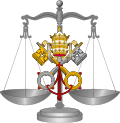Type of document issued by the Pope
In law, motu proprio (Latin for 'on his own impulse') describes an official act taken without a formal request from another party. Some jurisdictions use the term sua sponte for the same concept.
Contents
In Catholic canon law, it refers to a document issued by the pope on his own initiative and personally signed by him. [1] Such a document may be addressed to the whole church, to part of it, or to some individuals. [1] The first papal motu proprio was promulgated by Pope Innocent VIII in 1484. [2] It continues to be a common form of papal rescript, especially when establishing institutions, making minor changes to law or procedure, and when granting favours to persons or institutions.
